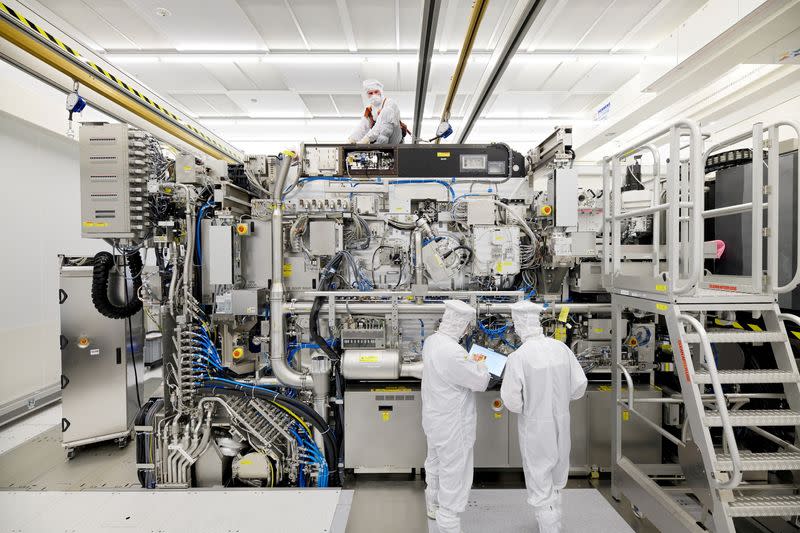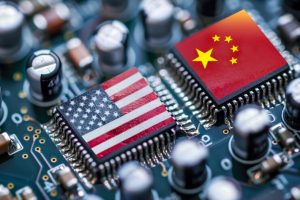China is on track to spend a whopping $50 billion to purchase chipmaking equipment this year, despite increased efforts by the United States to cut off Beijing from advanced semiconductor technologies.
The estimates, reported by Nikkei Asia citing data from industry lobby SEMI, come on the back of a scramble within China to set up new chip fabs and protect the country’s supply chains from new US sanctions.
That scramble has led China to spend a record $25 billion on chip equipment in the first half of the year, Nikkei reported.
Also on AF: China Threatens to Cut Off ASML Over New US Chip Curbs
That amount is more than the combined spending from South Korea, Taiwan and the US on chip tools during the period, the report noted.
In 2023, China spent nearly $37 billion on chipmaking equipment, according to SEMI. That was more than 34% of global chipmaking equipment purchases.
The huge jump in spending is in line with Beijing’s larger strategy of ploughing tens of billions of dollars into semiconductors — a technology in which it aims to achieve 70% self-sufficiency by next year.
In May, China set up a $47.5 billion fund to boost its chip industry. This was the third such fund launched by the China Integrated Circuit Industry Investment Fund, or “Big Fund”, and was bigger in value than the first two chip funds combined.
China’s local governments are also taking similar steps to boost their chip output. Just last week, Chinese capital Beijing set up its own chip fund with a registered capital of $1.2 billion.
Similarly, Shanghai city doubled the value of its chip fund by pumping in another $1 billion last month. Shanghai has also awarded a series of subsidies to projects led by Semiconductor Manufacturing International Corporation (SMIC) and Huawei in the city. Those projects include SMIC’s 300mm production lines which it is likely using to produce 5nm chips for Huawei’s smartphones.
Increased investments in chipmaking have meant that China is now only three years behind the world’s largest contract chipmaker, TSMC, in its semiconductor capabilities, according to a separate Nikkei report.
Year of recovery
China’s large spending has lifted the chip equipment market as it emerges from a slowdown in 2023.
China was the only country to increase its year-on-year chip equipment purchases, with other major buyers like Taiwan, South Korea and the US all spending less than last year, Nikkei said.
“We are seeing China continue to buy all the equipment they can for their new mature-node chipmaking facilities,” Nikkei quoted SEMI’s senior director of market intelligence, Clark Tseng, as saying.
The purchases have also meant that China was the biggest market for most leading chip equipment makers across the world.
The country accounted for nearly half the sales of ASML — the world’s dominant maker of lithography machines and Europe’s most valuable tech firm — in the first six months of the year.
Similarly, Japan’s Tokyo Electron earned 49.9% of its second-quarter revenue from the country.
China remains a significant source of revenue for US chipmakers too. It accounted for 32%, 39% and 44% of revenue for Applied Materials, Lam Research and KLA respectively, in the second quarter.
Chip firms continue to struggle
The spending on equipment also corresponds with China’s ambitious plans to expand its chipmaking ability. The country is set to lead the world in setting up new chip fabs, with plans to bring at least 18 new facilities online this year.
That has meant that equipment purchases in the first half have come not just from big names like SMIC but also mid-sized and smaller players.
But still, sustainability remains a major challenge for Chinese semiconductor firms.
Early this week chip start-up Xiangdixian Computing Technology, an up-and-coming GPU-maker, said it was facing “market adjustment pressures” and laying off some employees to cut costs.
The statement followed local media reports that said the firm was set to collapse after its shareholders froze the company’s bank accounts for failing to fulfil terms of a previous funding round. Xiangdixian denied the reports saying it had taken no steps to wind up “so far.” It added that it was looking for new investors.
Meanwhile, in July, chip firm Beijing Zuojiang Technology — which once claimed it had the potential to rival Nvidia — was delisted from the Shenzhen Stock Exchange over financial fraud.
Earlier, in January, Shanghai Wusheng Semiconductor Group — a firm set up with an investment of nearly $2.5 billion — began bankruptcy proceedings citing financial difficulties. It was liquidated in June.
The trend of Chinese chip firms shutting shop is by no means new. A staggering 26,646 chip-related Chinese companies have ceased operations since 2020. The number was highest last year, averaging 30 firms a day.
- By Vishakha Saxena
Also read:
ASML Has Sold One in Two Chipmaking Machines to China This Year
The World Needs China’s Legacy Chips, ASML CEO Says
US Curbs Set Off Sales, Tech Boom for China Chip Equipment Firms
China’s AI Chip Firms Downgrade Designs to Keep Access to TSMC
China Firms Rush to Poach Nvidia Clients With AI Chip Offerings
‘Four of Five Huawei AI Chips Defective’ as US Sanctions Bite
Huawei, SMIC Set to Defy US Sanctions With 5nm Chips
US Set to Double Tariffs on Chinese Semiconductors in 2025 – TH
























